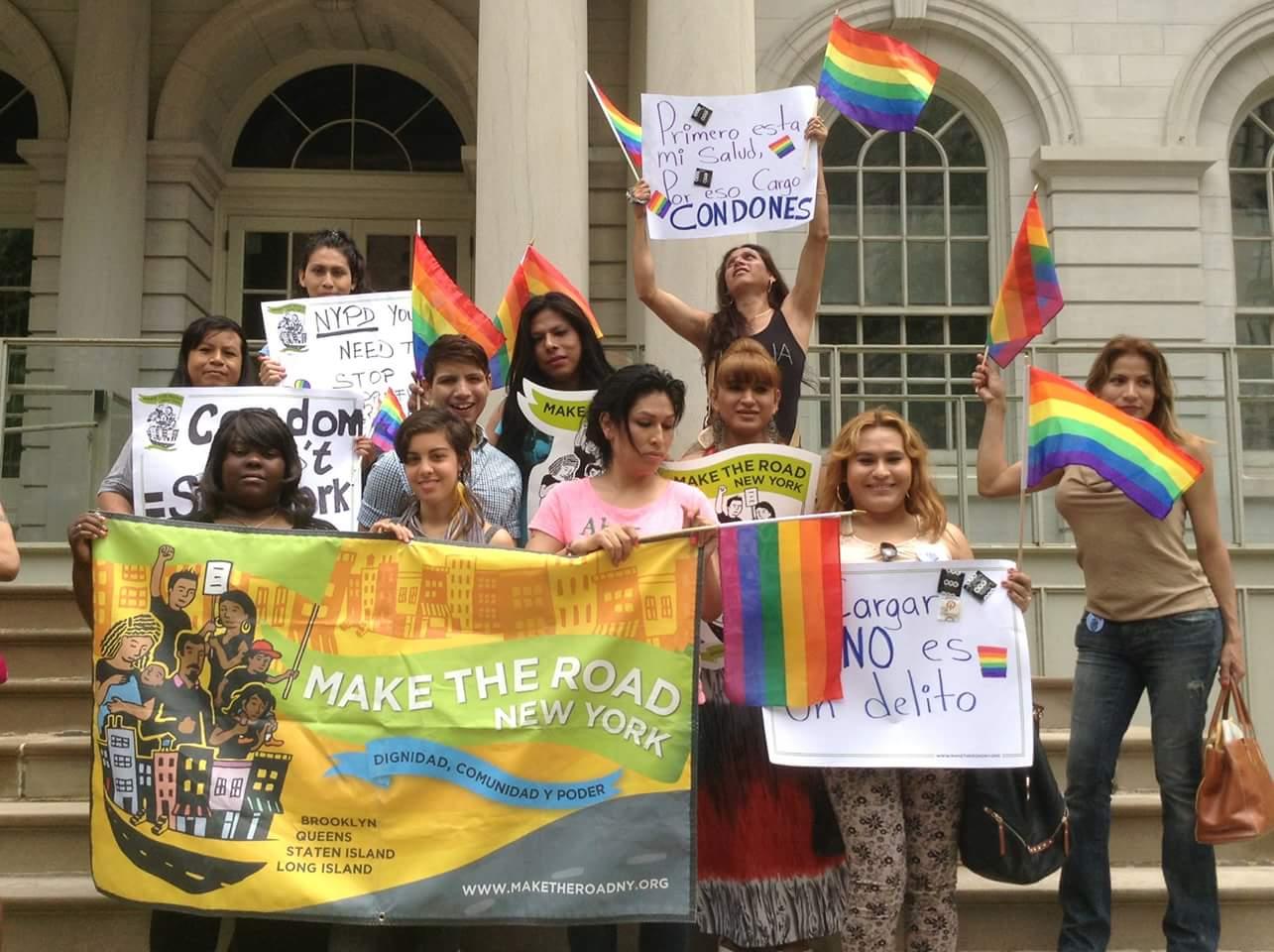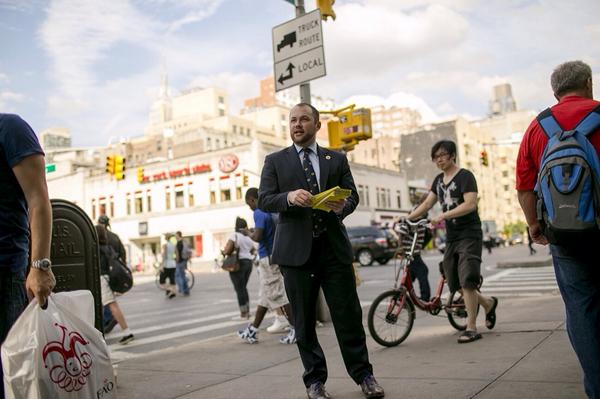Keeping the Water On: New York Must Address Infrastructure, Costs

A water main break (photo: Ben Max)
In the coming weeks, the New York City Water board will consider a 3.2 percent increase in the city's water rates. Understandably, many New Yorkers are opposed. Water bills rose by a whopping 166 percent during the Bloomberg administration; an increase that was painfully felt by so many low- and middle-income families. Yet Mayor de Blasio deserves credit for addressing affordability concerns while still ensuring a steady revenue source for the city's aging water infrastructure.
Water bills finance the city's most fundamental services: the delivery of clean water and the safe disposal of sewage and rainwater. Managing and maintaining this infrastructure is not cheap. Recent work on the Croton Filtration Plant, Catskill Disinfection Plant, and the Newton Creek Wastewater Treatment Plant Upgrade cost nearly $10 billion. As a result, the city's water and sewage debt rose from $11 billion in 2002 to $29 billion in 2013.
With the Department of Environmental Protection (DEP) devoting billions of dollars to filtering the city's water and cleaning its harbor, insufficient funding was left for maintaining and modernizing the city's water and sewage pipes. From 2001 to 2007, nearly 300 miles of sewers were constructed or reconstructed. From 2008 to 2014, a paltry 118 miles saw work. In his 2007 PlaNYC report, Mayor Bloomberg pledged to build or replace 80 miles of water mains annually. Since then, the DEP has installed only 28 miles per year.
The consequences of this neglect are troubling. In 2014, there were 513 water main breaks across the five boroughs, a 39 percent increase from 2012. The city has suffered at least 400 water main breaks in all but one year since 1998. As a result of these breaks and leaks, a staggering 21 percent of water that enters distribution mains never reaches customers in the city, double the 10-to-15 percent industry standard. To manage these leaks and breaks, repair the city's aging infrastructure and finance its ballooning debt, the DEP must increase its revenue. Mayor de Blasio's 3.2% water rate increase—which is far lower than the 8 percent average increase during the Bloomberg years—is a necessary, if perhaps insufficient, part of that equation.
While increased water rates are certainly a burden—particularly for low- and middle-income New Yorkers—these charges are still below the national average and only half that of residents in Seattle or Atlanta. The water bill for a typical single-family homeowner in New York comes to $88/month, a considerable amount but significantly less than most New Yorkers pay each month for their smart phones.
Fortunately, increased water rates are not the only method for financing and restoring the DEP's essential infrastructure. In 1985, the NYC Water Authority and Water Board were created so that utility payments would go directly and exclusively to the water and sewer system. As part of this agreement, the city charged the Water Board a "rental payment" to cover pre-1985 debt associated with the system. In 2005, as this old debt began to expire, the arrangement was altered. For the first time, the city charged rental payments that exceeded debt service. As a result, Water Board payments have climbed—from $117 million to $204 million over the last decade.
Though the administration insists that these payments are critical to funding the city's operating budget, this misses the point. Dedicated revenue should remain dedicated; not diverted to other programs.
Finally, in addition to a rate increase and the phasing out of rental payments, DEP must get more creative. While past commissioners have grumbled about the heavy burden of federal and state mandates, these are rarely as rigid as portrayed. In 2012, the city amended an agreement with New York State, allowing the DEP to reduce the city's 27 billion gallons of rain and sewage overflow with "green" infrastructure (such as green roofs and porous pavements) rather than exclusively with gray infrastructure (such as retention tanks and upgraded waste water treatment plants). Philadelphia avoided a similar Clean Water Act mandate by introducing a stormwater management fee in lieu of expanded treatment capacity. What would have been a multi-billion dollar expense was converted into a new revenue source.
New York City should follow Philadelphia, and 500 other cities, by replacing its sewer charges, currently assessed at 159 percent of the water rate, with a more nuanced stormwater management fee. Property owners would be charged based according to the percentage of rainwater captured on their lot (before it enters the city's overburdened sewer system). This would incentivize increased water retention on private property, with customers paying a lower fee as they introduce new green elements —trees, swales, porous pavement, and green roofs. This could be coupled with a credit program, repaid via the utility or property bill, to help customers finance the installation of green elements.
Repairing the city's water infrastructure and improving its stormwater management is critical to New York's economic competitiveness and environmental resiliency. Mayor de Blasio should hold firm on increasing water rates this year, eliminate rental payments, and introduce a stormwater management fee.
***
Adam Forman is research and communications associate at the Center for an Urban Future, a New York City based think tank. He is the author of "Caution Ahead," a report published by the Center documenting New York's infrastructure vulnerabilities.
***
@GothamGazette
Do you have an op-ed idea or submission for Gotham Gazette? Send it to Executive Editor Ben Max: This email address is being protected from spambots. You need JavaScript enabled to view it.
Access to Condoms: Partial Win in 2015 Budget

A rally to promote access to condoms
At the conclusion of a highly-contested budget season few advocates are claiming victories. Fair wage activists, ethics watchdogs and DREAMers, among others, are gearing up for a fight to have their issues addressed during the post-budget legislative session. But, on at least one issue, there is reason for progressives to be hopeful: expanding access to condoms.
As part of this year's budget deal, Albany lawmakers and Governor Cuomo passed a limited ban on the use of condoms as evidence. This is important because all too often when transgender New Yorkers, sex workers, trafficking victims, and others are profiled by police, officers use the fact that some have condoms in their possession as evidence of crimes. This undermines our state's commitment to providing access to contraception and preventing the spread of sexually-transmitted infections.
The limited ban on condoms as evidence originally proposed in the governor's budget and eventually adopted in the final budget deal is important recognition from policy-makers of what many of us have known for years: we need comprehensive legislation to ensure that condoms are not criminalized for sex workers, trafficking victims, youth in the sex trade, and anyone profiled as such by law enforcement.
While there is seldom disagreement on the importance of condom access, many are simply unaware of the current practice where law enforcement confiscates condoms as evidence of prostitution-related offenses. A recent PROS Network report found nearly 50% of respondents involved in the sex trade were victims of police confiscating, damaging, or destroying their condoms, and nearly 46% did not carry condoms at some point out of fear of the police.Condoms are taken out of the hands of those for whom they serve as a vital personal and public health tool and left to rot in evidence lockers, since they are rarely actually introduced at trial.
Still, the evidence ban is limited, and there remains much work to be done to ensure access to condoms for all.
With Governor Cuomo's monumental commitment to end AIDS in New York State by 2020, we expected decisive action to address HIV prevalence in communities impacted by the epidemic. What we saw instead was rhetoric without substance. The provision put forth by the governor is a partial ban that covers only two of almost twenty prostitution- and trafficking-related offenses. There is thus only a slim chance that this will have a significant impact on how the practice is executed on the ground. Law enforcement will continue to confiscate condoms, claiming them as evidence of one or more of the many offenses that are left out of the ban. Fear and confusion about whether and how condoms can be used against those carrying them will continue.
Possibly the most concerning aspect of this limited ban is that victims of sex trafficking remain excluded.
The exclusion of trafficking-related offenses creates a perverse incentive for traffickers to withhold condoms from the people they exploit to avoid prosecution, compromising the safety and dignity of the people they victimize. As recently stated by Florrie Burke, recipient of the inaugural Presidential Award for Extraordinary Efforts to Combat Sex Trafficking in Persons, "Policymakers shouldn't leave trafficking victims out of the solution. Their lives depend on it."
The good news is that there is widespread support for prioritizing the crisis of sex trafficking and the end of AIDS in New York State, both across party lines and at all levels of governance. Momentum is on our side and the solution is clear: the governor and the Legislature should get back to work on this issue and pass a bill (A.4463A/S.1018) to end the criminalization of condoms in New York State. The lives of some of the most vulnerable New Yorkers depend on it.
***
by Anna Saini and Bianey Garcia
Saini is the Statewide Community Organizer with Voices of Community Activists and Leaders – New York (VOCAL-NY).
García is an LGBTQ Justice Project Organizer at Make the Road New York. Both are members of the Access to Condoms Coalition, which is composed of over 100 organizations, including organizations that together serve the majority of New York's trafficking victims.
***
Have an op-ed idea or submission for Gotham Gazette? E-mail editor Ben Max: This email address is being protected from spambots. You need JavaScript enabled to view it.
Time for City to Overhaul Drug Strategy

Council Member Corey Johnson (photo: William Alatriste)
On Thursday, April 16, City Council Member Corey Johnson introduced legislation to create an Office of Drug Strategy to oversee New York City's myriad and sometimes contradictory approaches to the problems associated with drug use. This new office could play an important role in coordinating dozens of agencies that deal with relevant issues. Moreover, it could move the city away from a primarily punitive approach to drugs and toward one based on research and best practices - increasing the health and safety of individuals and communities while saving the city money.
Despite decades of a relentless War on Drugs, drugs are cheaper, of higher quality, and more easily available than ever. While concerted police action has helped remove much of the most visible drug dealing, drugs are widely available to anyone who wants them. Surveys indicate that high school students have almost universal access to drugs – though most choose not to use them. And relying on police and prisons to try to stomp out drug use has been a failure for people who use drugs and their families.
In recent years deaths from heroin overdoses have increased by 100%, killing more people than homicides. Too often people experiencing drug use problems are given few options. Existing voluntary drug treatment programs are overwhelmed by demand. Even those with good insurance have difficulty accessing high quality care. And stigma is widespread, in part because we continue to criminalize people who use drugs
The criminalization of drug users and dealers has fallen primarily on communities of color. In New York State 90 percent of those incarcerated on drug charges are black and Latino; similarly, about 85 percent of those arrested or ticketed for marijuana in New York City are people of color—despite the fact the drug use rates are similar across racial groups. This suggests that drug enforcement looks different in white communities than it does in communities of color. Police claim that this is because it is low-income communities of color that request their help. But this ignores the fact that for decades these communities have also pleaded without success for the jobs and health care services that would be more effective in reducing the illegal drug trade in their neighborhoods.
Meanwhile, large-scale drug trafficking continues without interruption because almost all of the law enforcement focus is on low level street dealing. Even when a higher level dealer is arrested, it merely results in a shifting of the players with no measurable effect on the basic functioning of the illegal drug trade.
New York City has already taken important steps to change course. Stop-and-frisk policing has been curtailed. Radically fewer people are being arrested for low-level marijuana offenses after a new policy adopted by the de Blasio administration last fall (though, troublingly, people of color remain the overwhelming targets of the thousands of arrests that still happen). And the city is developing new behavioral and mental health initiatives that prioritize health and social assistance instead of incarceration for people struggling with substance use or mental illness.
Increasingly, police officials themselves are speaking out. Houston Police Chief Charles McLelland has called the War on Drugs a "miserable failure." Recent books by former Baltimore police officer turned John Jay College professor Peter Moskos and former Seattle Chief of Police Norm Stamper have outlined in detail the utter futility of controlling drugs through traditional policing.
The new New York City Office of Drug Strategy would be tasked with bringing together numerous local agencies – from the health department to the police, homeless services, welfare, and more – to assess existing approaches and develop new ones based on systematic evaluation of what works to make individuals and communities healthier and safer. The office would produce annual progress reports and work closely with an advisory board made up of public officials, academic experts, service providers, and people with personal experience of drug use.
Council Member Johnson's bill makes clear that this new office would adopt a harm reduction approach to protecting health and public safety with the goal of reducing the morbidity, mortality, and crime, as well as inequities, stemming from past or current policies. This means that part of the office's work will be to overcome the negative effects of criminalization in poor communities of color, which too often drive people away from education and opportunity and toward violence, criminality, and prison.
Individuals, families, and communities need help dealing with very real problems stemming from drug use. It's time that the city takes seriously the need for a broad range of strategies based on research and experience. We know that these harms can be addressed if we have the political will and resources. A new Office of Drug Strategy could go a long way toward generating both.
***
Alex S. Vitale is Associate Professor of Sociology at Brooklyn College and author of City of Disorder: How the Quality of Life Campaign Transformed New York Politics.
Matt Curtis is Policy Director at VOCAL New York.
***
Have an op-ed idea or submission for Gotham Gazette? E-mail editor Ben Max: This email address is being protected from spambots. You need JavaScript enabled to view it.




